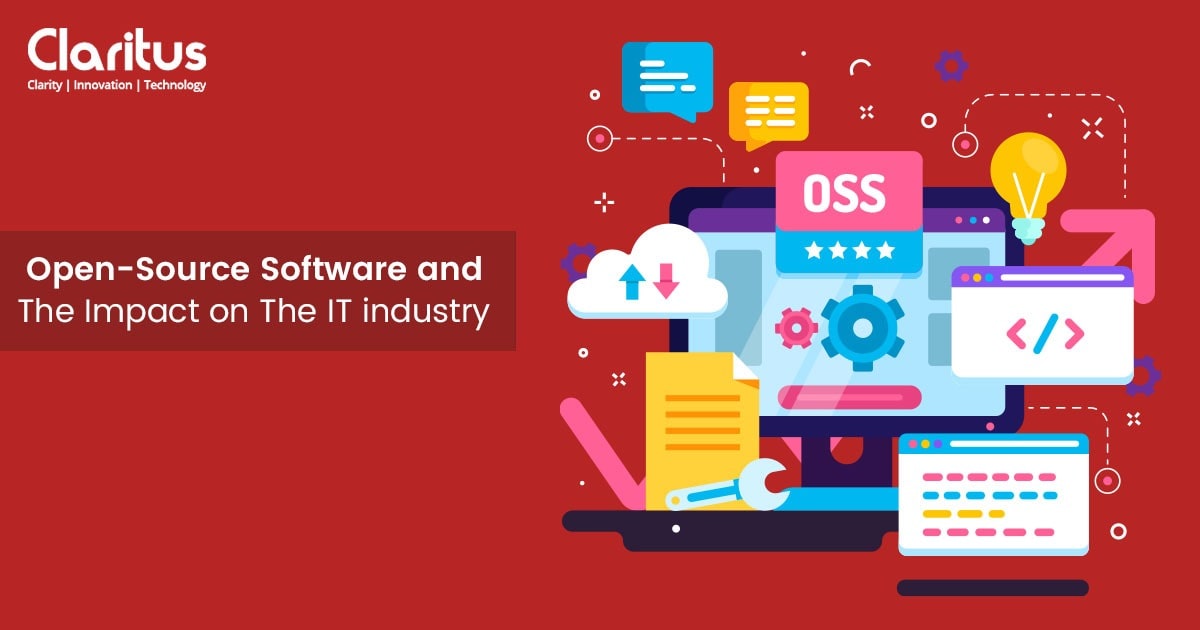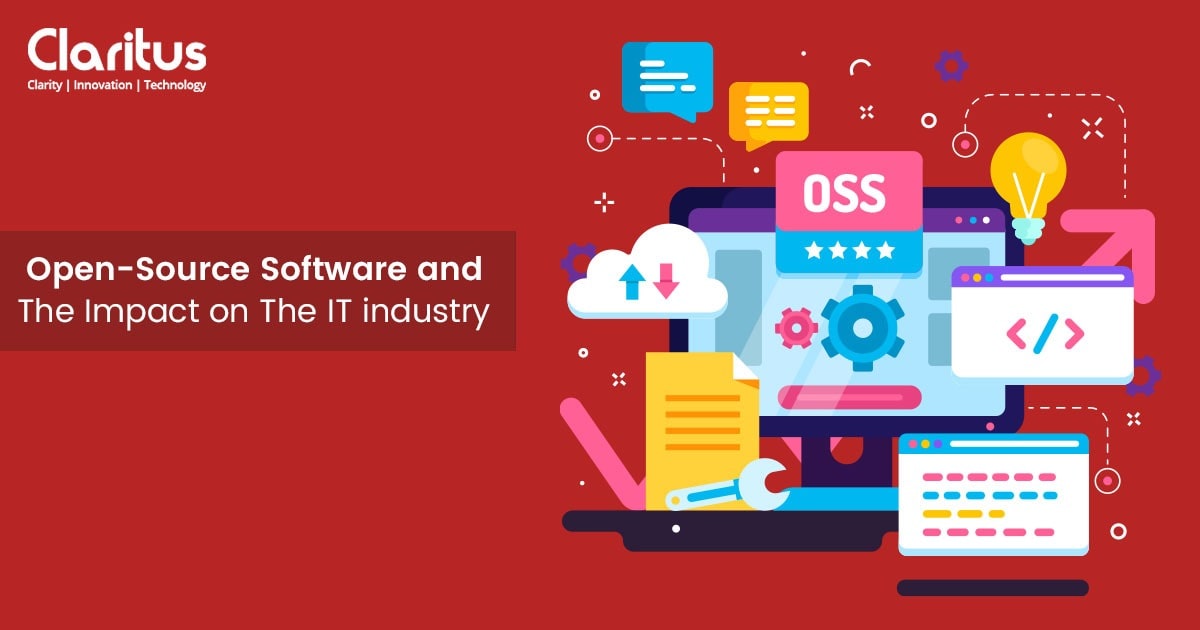Open-Source Software and The Impact on The IT industry

Open-source software (OSS) is made available with its source code, so that it can be used, modified and distributed with its original rights. Most computer users don’t ever get to see the source code which is actually a part of the software. Developers and programmers manipulate this code to control the behaviour of the application.
Accessing source code helps to alter a software programme by adding, deleting or bug fixing. OSS essentially includes a license that permits the computer personnel in modifying the software to fit their requirements and to properly manage its distribution. Actually, the expression open-source software indicates something in the design, which is publicly accessible and that anyone can modify and share.
Today, most of the modernization and uniqueness with regard to Cloud Computing, Artificial Intelligence (AI) and Big Data have been gleaned from OSS projects.
Why do programmers prefer Open-source software?
1. Security:
It’s considered more secure and stable vis-à-vis proprietary software. Any software personnel can view and modify it and may also detect and rectify flaws or omissions that the creators of the original software programme might have overlooked. Therefore, many professionals can work on a piece of this software, without any permission from its creators. This facilitates fixing, updating and upgrading OSS more swiftly than doing the same on proprietary software.
2. Command:
Many software professionals opt for OSS because they can exercise more supervision and hold more sway over it. They are able to scrutinize code to ensure that it’s perfectly working as intended and expected and not deviating from its objective or what it’s supposed to accomplish. Even ordinary users derive advantages by using it in any manner or for any purpose convenient to them.
3. Dependability:
Many software professionals prefer OSS to proprietary software for major and lengthy projects. Since source code for OSS is publicly distributed, software personnel and users dependent on it for crucial tasks can be confident that if its original developers and creators part ways then the tools will keep functioning without glitches and neither get neglected nor be out of order. Also, characteristics like enhanced security and high adoption by organizations raise the dependability of open-source software.
4. Training:
The software is also preferred because it’s easy to learn and aids learners in evolving into better programmers. Being publicly accessible, students can conveniently access it, study and ultimately are able to produce high-quality software. They can also share their work with others which obviously generate comment, analysis and evaluation, while they develop their proficiency. When bugs and errors are detected in the programme or source code, they can be circulated among others so that the mistakes are not repeated.
5. Collaboration:
Since the open-source community is very active and the open-source software is effectively scrutinized and refined by peer programmers, it can be rightly and appropriately termed as living code and not code which is closed and eventually becomes dead. The presence of active open-source communities signifies that perspectives, help and resources are readily available, which reach beyond a single interest group or one kind of business.
6. Transparency:
It’s easy to ascertain the different kinds of data and where they are heading together with the alterations and modifications in the code that have taken place. Any user can find out and track these without depending on the assurances of the vendors or creators.
7. Cost:
open-source software is so economical that it hardly creates any major financial impact on any business. It’s available at a fraction of the price of conventional, licensed or proprietary software solutions. This is because OSS does not require licensing fees. Therefore, there is no need to worry about recurring maintenance or licensing fees. So, any business of any size can access OSS regardless of its budget, which has hugely impacted the industry.
8. Speed:
No organization will compromise with this feature and OSS aptly facilitates this very requirement. Its flexibility helps in swift development and the end product is not clumsy or awkward but fast, practical and functional.
Some of the most well-known applications and cloud platforms in operation now have been derived from the Open-Source Development Model. The most admired and treasured among them is called LAMP. The acronym denotes
Linux – An open-source operating system.
Apache – An open-source cross-platform web server.
MySQL – An open-source relational database management system.
PHP – An all-purpose scripting language. Although, Perl and Python languages are sometimes used in place of it.
Other examples of open-source technologies are Android mobile OS, Mozilla Firefox web browser and office suites such as OpenOffice and LibreOffice. GitHub also hosts many open-source projects. Kubernetes, Linux and Ansible are illustrations of prominent open-source projects too.
Here are the Top 10 Awesome Open-Source Software You Must Try In 2023
We still love costly applications such as Adobe, Autodesk and Microsoft Windows. However, a software professional can easily replace them with a plethora of open-source alternatives which are readily available these days. An atrociously overpriced software can be substituted with one from free options including operating systems and other tools.
It’s easy to fall for the brand names and select expensive proprietary software for day-to-day tasks. On the other hand, the open-source ecosystem consists of software and tools with equally useful, effective and potent functionalities and sometimes with additional features and advantages not present in the costly ones.
Open-source software consistently remains a major part of IT. A report by Red Hat states that around 82% of IT heads and chiefs have intentions to work with open-source software companies and creators contributing to the community.
So proprietary ones keep losing business as most IT leaders desire to deploy OSS for emerging technologies. Also, another survey revealed that almost 90% of these leaders perceive open-source software security to be either equal to or better than paid, proprietary software.
So, what are the Best Open-Source Software examples of 2023?
1. Linux-
According to one survey, Linux is preferred by more than 83% of software professionals. This is an operating system (OS) just like macOS or Windows but the most user-friendly one available for deployment. It’s routinely and regularly used for Android gadgets and desktops and so can be ubiquitously located in smartphones, home appliances and even cars. It’s a unique one, being free, insanely customizable, extremely secure and offers great community support.
2. OpenOffice-
This one is similar and the best alternative to the expensive product, Microsoft Office. However, Apache OpenOffice is available entirely free of cost. It facilitates word processing, and superlative presentations and can balance spreadsheets endlessly. It contains Writer for word processing, Calc for spreadsheets, Draws for graphics, Math for mathematical equations, Impress for presentations and Base for databases.
3. LibreOffice-
Derived actually from OpenOffice, this one can also replace Microsoft Office. It contains all the features of OpenOffice together with some extra extensions and features and is completely free. LibreOffice is an exhaustive and comprehensive office suite that provides databases, spreadsheets, documents and presentations. Many users donate while downloading it so that the office suite is supported and it also has a vast community of enthusiasts and patrons.
4. Audacity-
This is one of the best examples of free open-source software for sound recording and audio-related tasks. It’s basically a digital audio editor and a multi-track audio recorder which can record audio from various sources, post-process any kind of audio, put together music and the like. Audacity also supports multiple plugins, so deploying this tool becomes an exciting affair.
5. Blender-
It is constantly mentioned and praised as one of the best open-source software for 3D animation and 3D modelling tasks. Conventional 3D animation software is quite pricey, but Blender is absolutely free and has been used many times for making standard-length animated films. It exhibits prowess in photorealistic rendering, animation, modelling, fast rigging, compositing, simulation and motion tracking etc.
6. Python-
Python is one of the most sought-after programming languages today. This OSS can be utilized for multiple functions like building desktop apps, web apps and video games, to name a few. This common programming and scripting language has of late, fascinated many software professionals for the convenience and user-friendliness it offers with regard to the development of Artificial Intelligence (AI) and Machine Learning. There are simply limitless possibilities to be obtained with this language, especially while using its libraries and IDEs.
7. Mozilla Firefox-
This is one of the most successful open-source software projects in the world. Released in 2002 this web browser is similar to Google Chrome. It’s also a default web browser for several Linux distributions. Its intelligent address bar and convenient user interface help programmers have a seamless experience. It is also in possession of an award programme which provides financial support to other open-source projects for their contributions to Mozilla’s work and internet health in general.
8. VLC Media Player-
VideoLAN Client (VLC) is a multimedia application introduced by the VideoLAN project, an open-source development group, in February 2001. Since then, most users across the world have been favourably inclined towards it, to enjoy the pleasant media consumption experience it generates. It’s unique because it can play audio and video in any format whatsoever. It’s also regularly upgraded and has modern features such as 360-degree video compatibility, pertaining to VR Headsets and the capability to sync with devices like Chromecast.
9. 7Zip-
This open-source file archiver was created by Igor Pavlov and introduced in 1999. It stores groups of files within containers called “Archives” in multiple compression formats. It’s an outstanding and leading archiving tool on the internet currently. It can efficiently produce a cabinet of similar files and assists users in organizing them. 7Zip is available free of cost and is considered to be far better than WinZip. Its ratio of compression is extremely high.
10. WordPress-
This is a free open-source Content Management System (CMS). It’s written in PHP using MySQL database. Although initially, it was a blogging platform, it ultimately evolved into a site builder and a separate entity as a CMS. It then literally took the world by storm and these days, around 43% of the world’s top 10 million websites use it and it’s on the rise. With it, Blogs, E-commerce and Business websites, E-learning and Portfolio websites etc. can be conveniently created.
Wrapping up
Diving deep into the realm of open-source software can help in finding interesting and practical software free of charge. A few of them mentioned in the list above may do a world of good to someone in search of such software, to begin somewhere in 2023.

